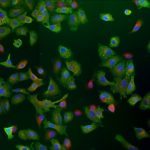Link to Pubmed [PMID] – 24694396
J. Gen. Virol. 2014 Jun;95(Pt 6):1233-43
Currently circulating H5N1 influenza viruses have undergone a complex evolution since the appearance of their progenitor A/Goose/Guangdong/1/96 in 1996. After the eradication of the H5N1 viruses that emerged in Hong Kong in 1997 (HK/97 viruses), new genotypes of H5N1 viruses emerged in the same region in 2000 that were more pathogenic for both chickens and mice than HK/97 viruses. These, as well as virtually all highly pathogenic H5N1 viruses since 2000, harbour a deletion of aa 80-84 in the unstructured region of the non-structural (NS) protein NS1 linking its RNA-binding domain to its effector domain. NS segments harbouring this mutation have since been found in non-H5N1 viruses and we asked whether this 5 aa deletion could have a general effect not limited to the NS1 of H5N1 viruses. We genetically engineered this deletion in the NS segment of a duck-origin avian H1N1 virus, and compared the in vivo and in vitro properties of the WT and NSdel8084 viruses. In experimentally infected chickens, the NSdel8084 virus showed both an increased replication potential and an increased pathogenicity. This in vivo phenotype was correlated with a higher replicative efficiency in vitro, both in embryonated eggs and in a chicken lung epithelial cell line. Our data demonstrated that the increased replicative potential conferred by this small deletion was a general feature not restricted to NS1 from H5N1 viruses and suggested that viruses acquiring this mutation may be selected positively in the future.


